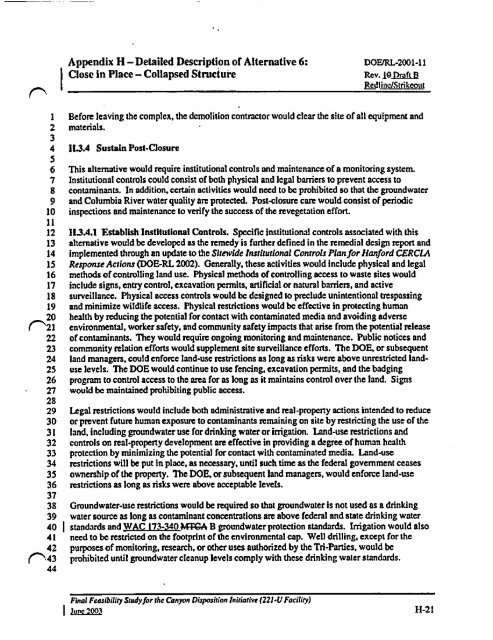View Document Here - Hanford Site
View Document Here - Hanford Site
View Document Here - Hanford Site
Create successful ePaper yourself
Turn your PDF publications into a flip-book with our unique Google optimized e-Paper software.
Appendix H - Detailed Description of Alternative 6: DOEIltl:2001-11<br />
Close in Place - Collapsed Structure Rev. le Draft e<br />
tLedlinelStri •eout<br />
1 Before leaving the complex, the demolition contractor would clear the site of all equipment and<br />
2<br />
3<br />
materials.<br />
4 111.3,4 Sustain Post-Closure<br />
5<br />
6 This alternative would require institutional controls and maintenance of a monitoring system.<br />
7<br />
8<br />
Institutional controls could consist of both physical and legal barriers to prevent access to<br />
contaminants. In addition, certain activities would need to be prohibited so that the groundwater<br />
9 and Columbia River water quality are protected. Post-closure care would consist of periodic<br />
10<br />
11<br />
inspections and maintenance to verify the success of the revegetation effort.<br />
12 113.4.1 Establish Institutional Controls. Specific institutional controls associated with this<br />
13 alternative would be developed as the remedy is further defined in the remedial design report and<br />
14 implemented through an update to the <strong>Site</strong>wide Institutional Controls Plan for <strong>Hanford</strong> CERCIlI<br />
15 Response Actions (DOE-RL 2002). Generally, these activities would include physical and legal<br />
16 methods of controlling land use. Physical methods of controlling access to waste sites would<br />
17 include signs, entry control, excavation permits, artificial or natural barriers, and active<br />
18 surveillance. Physical access controls would be designed to preclude unintentional trespassing<br />
19 and minimize wildlife access. Physical restrictions would be effective in protecting human<br />
20 health by reducing the potential for contact with contaminated media and avoiding adverse<br />
(0*^121 environmental, worker safety, and community safety impacts that arise from the potential release<br />
22 of contaminants. They would require ongoing monitoring and maintenance. Public notices and<br />
23 community relation efforts would supplement site surveillance efforts. The DOE, or subsequent<br />
24 land managers, could enforce land-use restrictions as long as risks were above unrestricted land-<br />
25 use levels. The DOE would continue to use fencing, excavation permits, and the badging<br />
26 program to control access to the area for as long as it maintains control over the land. Signs<br />
27<br />
28<br />
would be maintained prohibiting public access.<br />
29 Legal restrictions would include both administrative and real-property actions intended to reduce<br />
30 or prevent future human exposure to contaminants remaining on site by restricting the use of the<br />
31<br />
32<br />
33<br />
34<br />
land, including groundwater use for drinking water or irrigation. Land-use restrictions and<br />
controls on real-property development are effective in providing a degree of human health<br />
protection by minimizing the potential for contact with contaminated media. Land-use<br />
restrictions will be put in place, as necessary, until such time as the federal government ceases<br />
35<br />
36<br />
37<br />
ownership of the property. The DOE, or subsequent land managers, would enforce land-use<br />
restrictions as long as risks were above acceptable levels.<br />
38 Groundwater-use restrictions would be required so that groundwater is not used as a drinking<br />
39 water source as long as contaminant concentrations are above federal and state drinking water<br />
40<br />
41<br />
^ standards and WAC 173-340 #4T6,4 B groundwater protection standards. Irrigation would also<br />
need to be restricted on the footprint of the environmental cap. Well drilling, except for the<br />
42 purposes of monitoring, research, or other uses authorized by the Tri-Parties, would be<br />
(00N•43<br />
44<br />
prohibited untii groundwater cleanup levels comply with these drinking water standards.<br />
Final Feasibility Study for the Canyon Disposition Initiative (221 •U Facility)<br />
„ 100 .1 11-21

















